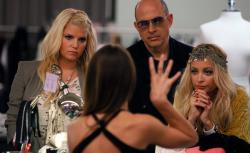I, for one, welcome our new media-and-marketing overlords. If you believe the New York Post—always a fun exercise—the phenomenon of Mad Men parties has reached critical mass, with public houses and private citizens hosting shindigs where guests display their loyalty to the show by dressing like extras and drinking like fiends. Such revelers are rather like Trekkies, but with tie-clips instead of transponders and a pretense to sophistication. That Mad Men parties, even though they are real, are also creations of AMC and its publicity team is fitting, for that show—expensive to produce, and watched by a smallish advance guard of opinion-drivers—is by necessity innovative in its marketing, branding, and ancillary-ing.
I am curious to know how many Sunday-night partygoers munching on Tribeca Treats’ Don cupcake (“a bourbon-soaked vanilla cake topped with a maraschino cherry”) do so while outfitted in Banana Republic’s limited-edition Mad Men Collection, which follows both an earlier Banana Republic experiment in licensing the brand and, forsooth, a similar Brooks Brothers venture. Me, I try to steer clear of BR, having once vented my frustration with its insipidity at a blameless saleslady. (I told her the trousers she wished to sell me were so dull they made my legs fall asleep.) The men’s clothes in the Mad Men line look, to my four eyes, like well-cut, normal clothes. The ladies’ collection is cheerful in its gentle nostalgia and wholesomely flirty. Don’t be surprised, this coming wedding season, to see flocks of bridesmaids decked out in the “future pink” Betty dress, attending to the betrothed’s fantasies of class and classiness, and tone-deaf to the wreck that the actual fictional Betty’s life has become.
Across the dial, the merchandising of TV shows proceeds in ways undreamed by the manufacturers of my A-Team lunchbox. Perhaps unsurprisingly, the most notable endeavors are conducted at Kabletown. NBC’s Fashion Star (NBC, Tuesdays at 10 p.m.) is a brutally cut-rate fashion-design contest—Project Runway with a shop-this-look-this-instant angle and zero interest in craft. Remember when NBC’s Ben Silverman wandered off to do exciting things with Barry Diller? Well, here, have some.
Diller’s IAC began its life as a subsidiary of the Home Shopping Network, and Fashion Star is the Home Shopping Network turned into a reality show. The contestants are sewing and stitching as guided by Nicole Richie, who has a healthy glow about her; by Jessica Simpson, who has found her proper level; and by the designer John Varvatos, who appears so outsized in his skeeviness that one can only assume it’s a put-on. The copious bracelets, the gradient tint of the blue-lensed sunglasses worn indoors, the lingering hugs with the contestants: It is a reptilian scene. At one point in the third episode, he wore a thing around his shoulders, and it was impossible to tell whether it were sweater, scarf, or discarded skin.
The celebutante, the singer, the sketchball—these are the mentors. But “it’s the buyers that have the last word,” insists the announcer. In the garment trade, it is ultimately the store buyers who determine designers’ futures, and so it is on this show, right on the tacky set. The contestants’ fates are in the hands of employees of Macy’s, Saks, and H&M. “If a designer makes a sale, they’ll be safe and you’ll be able to buy the clothes online or in stores the next day,” someone explains over music with a pre-partying bass line.
Each installment involves a few “fashion shows.” These tend to combine the oxygenated rush of an actual fashion show, the nuanced aesthetics of a Victoria’s Secret Fashion Show, and the aura of the once-in-fashion show Solid Gold. I caught an episode that involved models wearing summer clothes while, stage right, a trio of fly girls booty-danced to a pumping Katy Perry number. The sound was massaged so that the applause fell like steady lulling rain. At some point a young woman described as a “digital fashionista” hounded me about Fashion Star-related hashtags and, it seemed, threatened to hug one of the contestants to death until I tweeted one. The host is Elle Macpherson, and at a typical moment of truth, she turned to the buyers to ask, “Do we have any offers for Orly this evening?” Her tone wavered between that of a Sotheby’s auctioneer and a brothel madam in an Emmanuelle sequel.
This weekend, NBC has topped itself in the race to the bottom with an actual race. The reality show Escape Routes—which debuted two days ago, on the televisual tundra of Saturday night—“follows six teams as they drive in the all-new 2013 Ford Escape from city to city, competing for cash and prizes.” The program is difficult to enjoy but fascinating to study—an interactive full-show product placement inviting viewers to treat contestants as pieces in a board game.
You can send tweets to help the teams advance through their missions. You can follow them in online video. You can win a 2013 Ford Escape, of course. Scrolling through the series’ website, you can smirk at your fellow consumers’ tweets and chat messages, delighting yourself at utterances including “can u see our chat?” and “I’m watching, but I can barely hear you” and “While ya’ll on the road me and @WhitterzForPR is working on getting yall on Dancing with the stars!!!” For all the technology, the approach is retro, harkening back beyond the on-camera salesmanship of Dick Cavett and Ed Sullivan unto the days of Henry Ford. You can nurture your bile for Escape Routes in any color you want, as long as it’s black.
